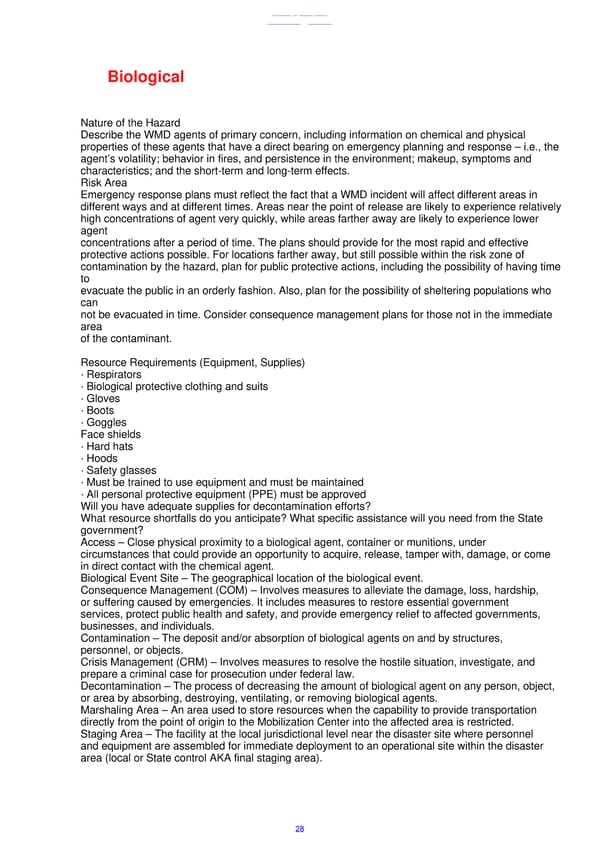Biological Nature of the Hazard Describe the WMD agents of primary concern, including information on chemical and physical properties of these agents that have a direct bearing on emergency planning and response – i.e., the agent’s volatility; behavior in fires, and persistence in the environment; makeup, symptoms and characteristics; and the short-term and long-term effects. Risk Area Emergency response plans must reflect the fact that a WMD incident will affect different areas in different ways and at different times. Areas near the point of release are likely to experience relatively high concentrations of agent very quickly, while areas farther away are likely to experience lower agent concentrations after a period of time. The plans should provide for the most rapid and effective protective actions possible. For locations farther away, but still possible within the risk zone of contamination by the hazard, plan for public protective actions, including the possibility of having time to evacuate the public in an orderly fashion. Also, plan for the possibility of sheltering populations who can not be evacuated in time. Consider consequence management plans for those not in the immediate area of the contaminant. Resource Requirements (Equipment, Supplies) · Respirators · Biological protective clothing and suits · Gloves · Boots · Goggles Face shields · Hard hats · Hoods · Safety glasses · Must be trained to use equipment and must be maintained · All personal protective equipment (PPE) must be approved Will you have adequate supplies for decontamination efforts? What resource shortfalls do you anticipate? What specific assistance will you need from the State government? Access – Close physical proximity to a biological agent, container or munitions, under circumstances that could provide an opportunity to acquire, release, tamper with, damage, or come in direct contact with the chemical agent. Biological Event Site – The geographical location of the biological event. Consequence Management (COM) – Involves measures to alleviate the damage, loss, hardship, or suffering caused by emergencies. It includes measures to restore essential government services, protect public health and safety, and provide emergency relief to affected governments, businesses, and individuals. Contamination – The deposit and/or absorption of biological agents on and by structures, personnel, or objects. Crisis Management (CRM) – Involves measures to resolve the hostile situation, investigate, and prepare a criminal case for prosecution under federal law. Decontamination – The process of decreasing the amount of biological agent on any person, object, or area by absorbing, destroying, ventilating, or removing biological agents. Marshaling Area – An area used to store resources when the capability to provide transportation directly from the point of origin to the Mobilization Center into the affected area is restricted. Staging Area – The facility at the local jurisdictional level near the disaster site where personnel and equipment are assembled for immediate deployment to an operational site within the disaster area (local or State control AKA final staging area). 28
 Military English. Learning by Doing. Book Page 9 Page 11
Military English. Learning by Doing. Book Page 9 Page 11